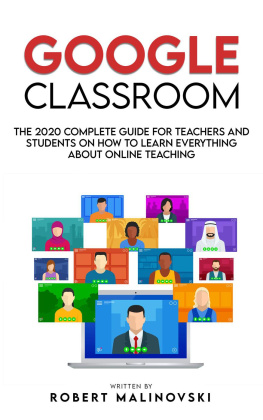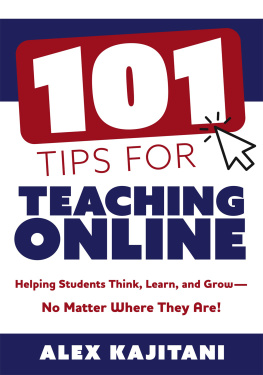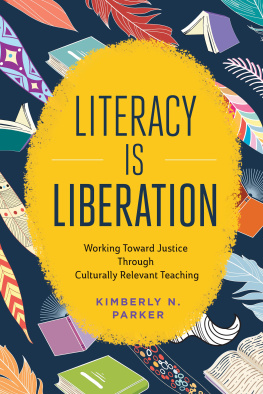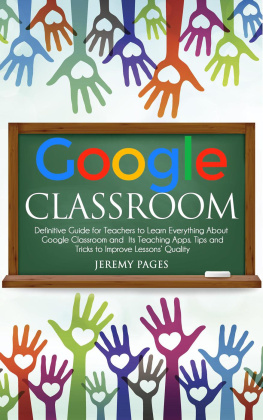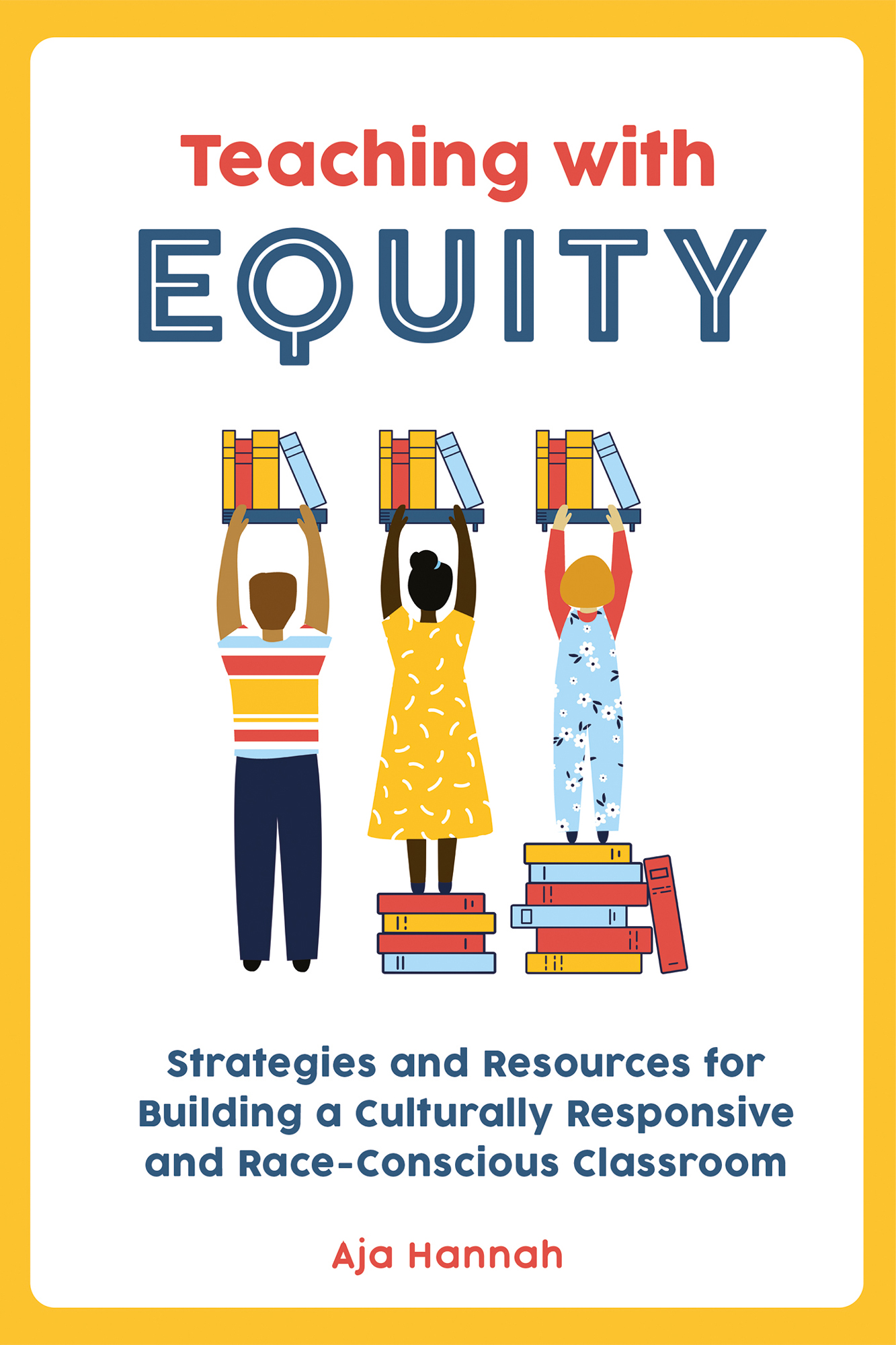CONTENTS
Guide
Teaching with Equity
Strategies and Resources for Building a Culturally Responsive and Race-Conscious Classroom
Aja Hannah
Text copyright 2022 Aja Hannah. Design and concept copyright 2022 Ulysses Press and its licensors. All rights reserved. Any unauthorized duplication in whole or in part or dissemination of this edition by any means (including but not limited to photocopying, electronic devices, digital versions, and the internet) will be prosecuted to the fullest extent of the law.
Published by:
ULYSSES PRESS
PO Box 3440
Berkeley, CA 94703
www.ulyssespress.com
ISBN: 978-1-64604-356-9
ISBN: 978-1-64604-379-8 (Ebook)
Library of Congress Control Number: 2022932318
Acquisitions editor: Claire Sielaff
Managing editor: Claire Chun
Project editor: Renee Rutledge
Editor: Lauren Schiffman
Proofreader: Joyce Wu
Front cover design: Ashley Prine
Cover artwork: from shutterstock.comstudents Batshevs; books Marina Akinina
Interior design: what!design @ whatweb.com
Production: Winnie Liu
NOTE TO READERS: This book is independently authored and published. No endorsement or sponsorship by, or affiliation with, copyright and trademark holders is claimed or suggested. All references in this book to copyrighted or trademarked products are for the purpose of commentary, criticism, analysis, and literary discussion only.
INTRODUCTION
Why do we need equity when we have equality? Werent Black kids bussed to White schools? Didnt we strike down separate but equal in the 1950s?
Yes. We did. We also created a culture of assimilation instead of integration. We ignored the beautiful differences in our communities and country. We ignored the disadvantages and hurdles placed in front of certain groups of people.
Equality is when every student is given the same resources in order to succeed. This sounds good until equality isnt enough to make up for the deficits history or public policy has created.
Thats where equity steps in. Equity is when you give specialized tools to certain students so that all kids are on a level playing field. A synonym for equity is fairness.
What is Equality? These definitions may be hard to understand, so imagine you have a classroom of students all learning to read. You give five minutes of individual instruction to every student after a lesson. Some students dont need the five minutes. They already understood the lesson. Some students use the five minutes, and the subject matter clicks. Then there is one student that needs more than five minutes. They are almost there. They just need something more. So you or an aide gives the student some more time. Thats an example of surpassing equality and finding equity.
What is Equity? Heres another example. Imagine a wall in front of a blackboard. The wall cannot be removed. Three students are standing in front of the wall, trying to see over it. One student is tall enough to see over it, and he dutifully takes notes. The other two are shorter to different degrees. They cannot see over the wall to the blackboard. A way to make this situation equal is to give everyoneeven the tallest childa stepping stool to see over the wall. But what if this stepping stool is still too short for the shortest child? Is it OK because everything is equal? Is it OK because the two tallest children say they can see fine?
A way to make the blackboard situation equitable is to give the two shorter children stools that make them the same height as the tallest child; that may mean having different-sized stools and that the tallest child doesnt get a stool. Now everyone can see over the wall at the same height. That is what this book hopes to do for the classroom.
When I was a first-year student in high school, I took a test in math class that included a word problem about a baseball game. The word problem assumed I knew how many innings were in a baseball game. It assumed I knew the mechanics of a game. I did not. I could not figure out the answer without this information, and it turned out that many of the other students in the class could not either.
After the teacher graded the questions, we asked him why he didnt provide this information. He said it was common knowledge. The class erupted with shouts of no and even some students remarking that it wasnt fair. We werent aware we needed to know about baseball. What did baseball have to do with math?
The teacher asked how many of us got it wrong, and over half the students raised their hands. He decided not to count the question as part of our grades but to let those who got it right earn extra credit. Then he half-heartedly reprimanded us for not knowing something so common.
This. This right here is why equity is needed in classrooms. This teacher had been using the same question for years without looking at it in relation to the diversity in his class. His advanced math class had changed from primarily cisgender White men like himself to a mixture of White and brown and Asian girls and boys, many of whom did not care about Americas favorite pastime.
This teachers common knowledge question became a challenge for students who were different. While his test question was dealt out equally to each student, it was not equitable.
How often does this happen without teachers realizing it? How can teachers who want to do better, do better?
As a disclaimer, this book is not focused on critical race theory and is not a guide on how to talk about race with your students. This book also does not cover equity in relation to other aspects of life like neurodivergence or LGBTQ (lesbian, gay, bisexual, transgender, and queer) issues. These talks are long and complex, and although they intersect with racial equity, there is not enough space in this book to give these areas any comprehensive justice.
Teaching with Equity focuses on racial equity for Black, Asian, and Latinx Americans as well as the Indigenous people of the US, including Native Hawaiians. Anti-racist activists may think Im going easy on Racism with a capital R, and it is true that Im going to try to avoid this word and some of the harder parts of racism.
Im doing this because I want to see change in classrooms, even if it is the littlest change. I want all teachers to be receptive to the suggestions in this book. Sometimes the word racism or racist can be triggering to the White community. This book may be assigned or suggested reading for teachers who are not necessarily on board with changing how things have always been done. I dont want them to get hung up on their feelings and miss the larger picture.
I also want to make issues of race easy to understand. While racism is a complex and intersecting issue in education and no one race is a monolith, there are some common difficulties that can be addressed. Because no one person can speak for their race or all races, I have interviewed some experts who have shared personal history, community stories, and expert knowledge.
Common threads of racism for people of color include colorism, sexualization and fetishization, microaggressions, and marginalization when it comes to representation in the US. Children of color are aware of these issues even in elementary school. Then there are topics specific to each race or culture like slavery for Black students or the model minority myth for East Asian students.



